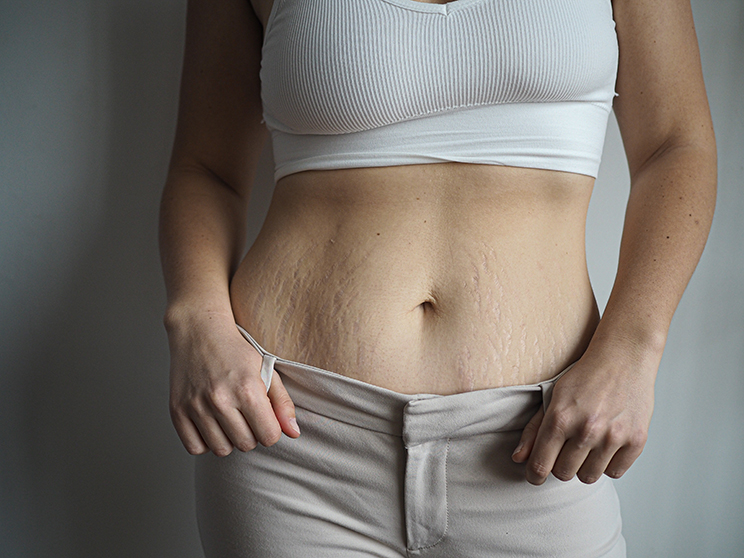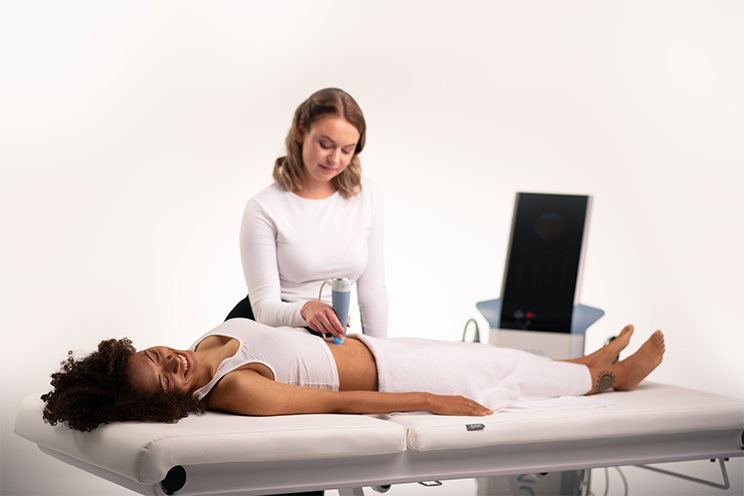Raskausarvet – mistä ne johtuvat ja miten niitä voi hoitaa?

Raskausarvet, joita kutsutaan myös nimellä striae tai venytysarvet, ovat tavallinen mutta monelle kiusallinen iho-ongelma, joka liittyy ihon nopeaan venymiseen. Erityisesti naiset kohtaavat raskausarpia raskauden aikana ja sen jälkeen, mutta niitä voi esiintyä myös muissa tilanteissa, joissa paino muuttuu nopeasti, kuten lihomisen tai laihdutuksen yhteydessä.
Raskausarvet syntyvät, kun ihon elastiset kollageenisäikeet venyvät nopean kasvun seurauksena ja ihokerrokset vaurioituvat. Alkuvaiheessa raskausarvet voivat olla väriltään punaisia tai sinisiä, mutta ajan myötä ne haalistuvat vaaleiksi tai kellertäviksi, ja niiden pinta jää ihosta koholle tai painuneeksi, jolloin arvet erottuvat ympäröivästä ihosta selkeästi. Vaikka raskausarvet eivät vaikuta fyysiseen terveyteen, ne voivat herättää esteettisiä huolia ja vaikuttaa itsetuntoon, sillä monet kokevat niiden olevan epämiellyttävä näky iholla.
Miten raskausarvet syntyvät?
Raskausarvet syntyvät pääasiassa ihon nopean venymisen vuoksi, joka kohdistuu erityisesti keskimmäiseen ihokerrokseen eli dermikseen, jossa suurin osa ihon kollageenisäikeistä sijaitsee. Raskaus ja sen mukanaan tuomat hormonaaliset muutokset, erityisesti estrogeenin ja kortisolin lisääntyminen, vaikuttavat ihon kimmoisuuteen ja heikentävät kollageenin tuotantoa. Kun iho venyy nopeassa tahdissa, dermiksen kerros repeää, mikä aiheuttaa ihon pinnalle arvenomaisia juovia. Tämä repeytyminen näkyy aluksi värillisinä arpinauhoina, kunnes iho alkaa hiljalleen korjata itseään ja arvet haalistuvat.
Raskausarpien syntymiseen vaikuttaa myös perinnöllinen alttius, sillä taipumus arpeutumiseen on osittain geneettistä. Lisäksi ihotyypillä on merkitystä; esimerkiksi vaaleaihoisilla raskausarvet saattavat näkyä herkemmin kuin tummempi-ihoisilla.
Ihon rakenne ja kimmoisuus määrittävät pitkälti, miten iho reagoi äkilliseen venytykseen. Ihmisillä, joilla on taipumusta kehittää keloidi- tai hypertrofisia arpia, raskausarvet voivat pahimmillaan muuttua kohonneiksi ja koviksi, mikä tekee niistä vaikeammin hoidettavia.
Venytysarvet voivat sijaita missä tahansa kehon kohdissa, mutta ne esiintyvät yleisimmin vatsan, reisien, lantion, rintojen ja käsivarsien alueella, sillä nämä alueet ovat herkimpiä nopeille muodonmuutoksille.

Raskausarpien tyypit ja vaiheet
Raskausarvet voidaan jakaa eri tyyppeihin ja vaiheisiin niiden ulkonäön, rakenteen ja kehitysvaiheiden perusteella. Useimmissa tapauksissa raskausarvet käyvät läpi kaksi selkeää kehitysvaihetta: akuutin vaiheen (striae rubra) ja kypsän vaiheen (striae alba).
- Striae Rubra: Tämä on raskausarpien alkuvaihe, jolloin arvet ovat vielä tuoreita ja niiden väri on tyypillisesti punainen, sinertävä tai violetti. Verisuonet kuultavat ihon läpi, mikä aiheuttaa kirkkaan värin. Striae rubra -vaiheessa arvet saattavat olla hieman koholla ja jopa kutisevia. Tämä on myös vaihe, jolloin arvet ovat parhaiten hoidettavissa, sillä tuore arpikudos reagoi hoitoihin nopeammin kuin kypsynyt arpi.
- Striae Alba: Kun raskausarvet kehittyvät ja kypsyvät, ne siirtyvät striae alba -vaiheeseen, jossa arvet muuttuvat valkoisiksi, vaaleiksi tai kellertäviksi. Kypsässä vaiheessa ihon verisuonet ovat vetäytyneet pois arpialueelta, jolloin arven värisävy haalistuu ja arpi usein tasoittuu osittain. Tämä on pysyvämpi vaihe, ja näiden arpien häivyttäminen on haastavampaa kuin tuoreiden arpien.
- Keloidiarvet ja hypertrofiset arvet: Joissakin tapauksissa raskausarvet voivat muuttua erityisen kohonneiksi ja paksuuntuneiksi, jolloin niitä kutsutaan hypertrofisiksi tai keloidiarviksi. Keloidiarvet ulottuvat alkuperäisen arven ulkopuolelle ja voivat kasvaa kooltaan, kun taas hypertrofiset arvet pysyvät alkuperäisen vaurion rajojen sisällä. Molemmat arpilajit voivat olla kosmeettisesti haastavia, ja niiden häivyttäminen voi vaatia ammattilaisen hoitoa.
Raskausarpia voi esiintyä eri muodoissa ja sävyissä, ja niiden ulkonäkö sekä hoitomahdollisuudet riippuvat pitkälti siitä, missä vaiheessa arvet ovat ja miten yksilöllinen ihotyyppi reagoi arpeutumiseen. Näiden arpityyppien tuntemus voi auttaa valitsemaan oikean hoitomuodon ja vähentämään raskausarpien näkyvyyttä.

Miten hoitaa raskausarpia?
Alla on listattuna suosituimpia hoitomuotoja raskausarpien häivyttämiseksi:
- EXION Fractional RF: Eri syvyyksille asetettujen mikroneulojen välissä kulkee radioaaltoja, jota lämmittävät kudoksia hellävaraisesti ja stimuloivat kollageenin tuotantoa.
- EXION Clear RF: Stimuloi kollageenin ja elastiinin tuotantoa, mikä kiinteyttää ja uudistaa ihoa sisältäpäin, tehden raskausarvista huomaamattomampia.
- Profhilo Body: Kosteuttaa ja uudistaa ihoa syvältä, parantaen ihon kimmoisuutta ja rakennetta. Se tekee raskausarvista ja ihon epätasaisuuksista vähemmän näkyviä
- Mesoterapia ja biorevitalisaatio: Kosteuttavat ja ravitsevat ihoa syvältä, tukien ihon uusiutumista ja parantaen sen laatua. Ne eivät poista raskausarpia suoraan, mutta auttavat ihoa palautumaan ja näyttämään tasaisemmalta ja elinvoimaisemmalta.
- Laserhoito: Käyttää lasertekniikkaa stimuloimaan ihon uusiutumista ja kollageenintuotantoa. Sopii erityisesti striae rubra -vaiheen arpiin.
- Retinoidivoiteet: A-vitamiinipohjaiset voiteet, jotka stimuloivat ihon solujen uusiutumista. Ei suositella raskauden aikana.
- Kemiallinen kuorinta: Kuorinta poistaa ihon pintakerroksia, mikä voi vähentää ihon epätasaisuutta ja auttaa uusien ihosolujen muodostumisessa.
- Silikonigeeli tai -laastari: Muodostaa iholle suojan ja tasoittaa kohonneita arpia, kuten keloideja ja hypertrofisia arpia.
- Kollageenilisät: Suun kautta otettavat lisät voivat parantaa ihon kimmoisuutta, mikä tukee arpien häivytystä.
MESQ®
DoctusPlus Oy:n aputoiminimi
Yritys
DoctusPlus Oy
Y-tunnus
3154088-6
Käyntiosoite
Itämerenkatu 11-13 F, 00180 Helsinki
Puhelin
Sähköposti
Aukioloajat
Ma – Pe 11:00 – 19:00